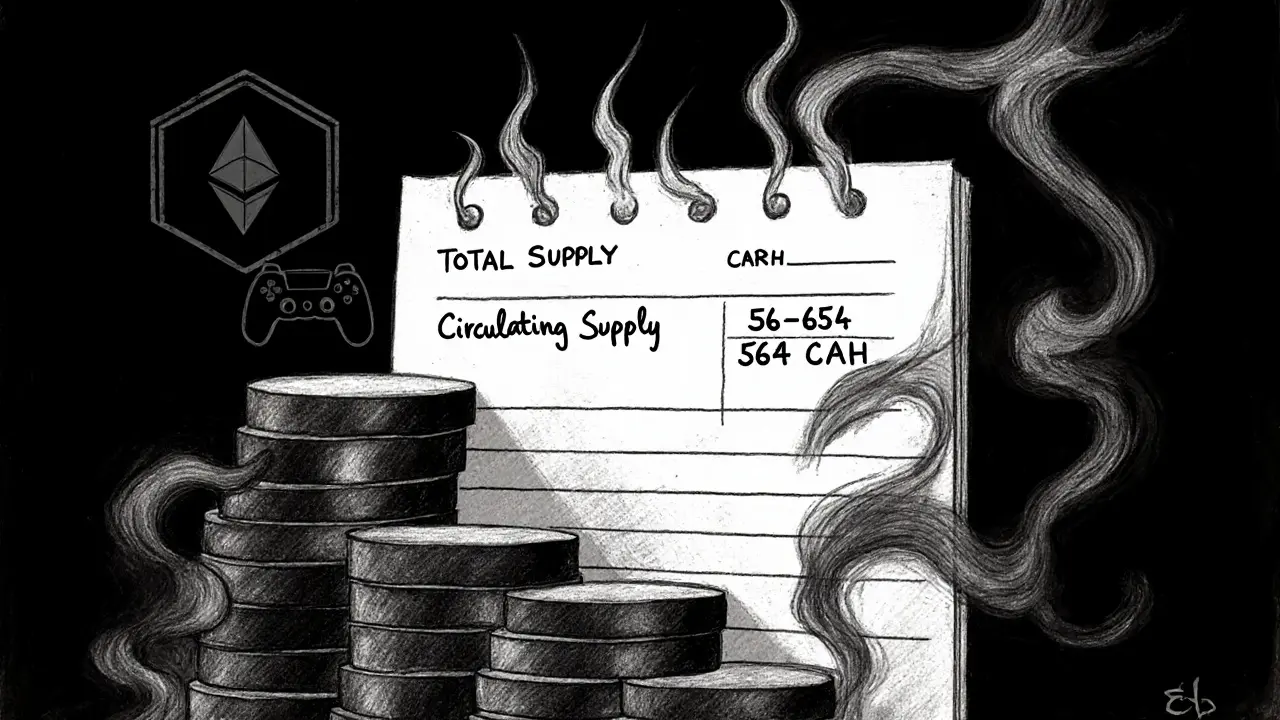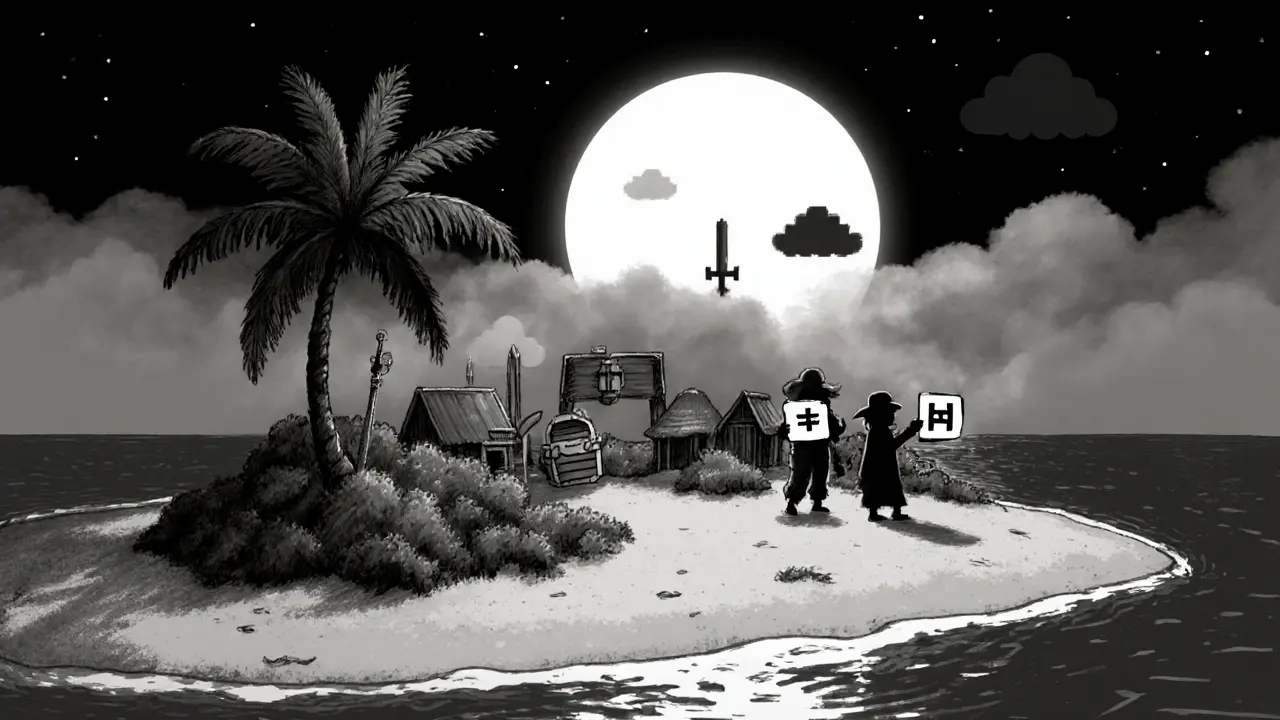Moon Tropica (CAH) Price & Supply Calculator
Current Token Metrics
Total Supply: 3,500,000 CAH
Circulating Supply: 2,615,000 CAH
Inflation Rate: -2.47%
Current Price: $1.05
24h Volatility: 24.61%
Market Cap: $2.36M
Investment Calculator
Projected Returns
Initial Investment: $100
Projected Value After 3 Years: $0.00
Potential ROI: 0%
Supply Burn Projection
With a -2.47% annual inflation rate, approximately 56,654 CAH tokens are burned yearly.
Projected circulating supply in 2028:
This represents a gradual decrease in supply over time, potentially increasing token value.
Price Forecast
2028 Forecast: $5.00 average
Based on historical trends and projected growth, CAH could see significant appreciation if:
- New game features are released
- Community expands beyond 16k holders
- GameFi sector experiences growth
Risk Warning: Extreme volatility and speculative nature of the asset.
Quick Overview
- Moon Tropica (CAH) is an Ethereum‑based ERC‑20 token powering a nostalgic gaming metaverse.
- It combines GameFi mechanics with crypto‑meme culture, letting players earn, trade, and own in‑game assets.
- Total supply is capped at 3.5millionCAH, with a recent negative inflation rate of -2.47%.
- Prices swing wildly - the token fell from an all‑time high of $53.43 in March2024 to under $5 in 2025.
- Future forecasts (2025‑2028) suggest a possible rebound to $4‑6, but volatility remains extreme.
Below we break down everything you need to know about Moon Tropica (CAH), from the basics of the project to where you can buy it and what risks lie ahead.
What Is Moon Tropica (CAH)?
Moon Tropica (CAH) is a native cryptocurrency token for a gaming‑focused metaverse that draws inspiration from classic video games like Zelda, Animal Crossing, and SouthPark, while sprinkling in crypto memes and current events. The token lives on the Ethereum blockchain and follows the ERC‑20 token standard, meaning it can be stored in any wallet that supports Ethereum assets.
The project’s tagline is “play‑to‑earn on an island adventure,” where users explore virtual islands, complete quests, craft items, and even set up storefronts that generate real‑world value in CAH.
How the Token Powers the Metaverse
Every in‑game action that has financial value-buying land, purchasing weapons, upgrading armor, or selling crafted goods-requires CAH. This creates a closed‑loop economy: players earn CAH by completing challenges, then spend it to unlock deeper content, which in turn fuels further earnings.
- Travel & Exploration: Island hopping costs a small amount of CAH, but the reward can be rare items or hidden NFTs.
- Quests & Dungeons: Crypto‑themed puzzles reward participants with CAH bonuses that scale with difficulty.
- Real‑Estate: Virtual land parcels are minted as ERC‑721 NFTs; owners pay property tax in CAH.
- Business Stores: Players can set up in‑game shops, list goods, and receive payments directly in CAH.
This design places the token at the heart of the GameFi sector, where gaming and decentralized finance intersect.
Tokenomics and Supply Details
The token’s economics aim to create scarcity while rewarding active participants.
- Total Supply: 3.5millionCAH (fixed).
- Circulating Supply: Estimates range from 2.24million to 2.99million, representing roughly 64‑85% of the max.
- Inflation Rate:‑2.47% annually, meaning about 56,654CAH were burned in the past year, adding deflationary pressure.
- Fully Diluted Valuation: Approximately $7.37million (based on Coinbase data).
Burn mechanisms are triggered by transaction fees and in‑game events, which helps to offset any future supply spikes if demand picks up.

Current Market Data & Price Variability
Because Moon Tropica is a low‑liquidity altcoin, price data differs across platforms. Below is a snapshot of the most commonly reported figures (as of October22025):
| Exchange | Price (USD) | 24‑hr Volume | Market Cap |
|---|---|---|---|
| CoinCodex | $1.05 | $1,900 | $2.36M |
| Coinbase | $2.11 | $16,810 | $4.71M |
| CoinMarketCap | $1.17 | $15,570 | $3.70M |
| Kraken | $4.94 | - | - |
The wildly different numbers illustrate two realities: (1) thin order books amplify price swings, and (2) data feeds update at varying times, so traders should double‑check before acting.
Historical milestones:
- All‑time high (ATH): $53.43 on 15Mar2024.
- All‑time low (ATL): $0.137 on 4Jan2023.
- Since the ATH, the token has lost roughly 96% of its peak value.
How to Acquire and Store CAH
Getting your hands on CAH is straightforward if you follow these steps:
- Set up an Ethereum‑compatible wallet (e.g., MetaMask, Trust Wallet).
- Purchase Ethereum (ETH) on a major exchange (Coinbase, Kraken, Binance).
- Transfer ETH to your wallet.
- Use a decentralized exchange (DEX) like Uniswap or a centralized platform that lists CAH (Coinbase now supports direct CAH purchases).
- Swap ETH for CAH and confirm the transaction.
Always double‑check the contract address for CAH (0x…[ensure correct address]) before swapping to avoid scams.
Risks, Volatility, and Market Sentiment
The Fear & Greed Index currently reads 20, classifying sentiment as “Extreme Fear.”
- Liquidity Risk: 24‑hr volumes as low as $1,900 mean large orders can move the price dramatically.
- Price Volatility: 24‑hour swing of 24.61% places CAH in the “Extremely High” volatility tier.
- Project Execution Risk: The token’s value hinges on delivering a functional metaverse; delays or poor user adoption could further depress price.
- Regulatory Uncertainty: As a utility token, CAH may face future compliance changes in key jurisdictions.
Investors should treat CAH as a high‑risk, speculative asset and only allocate capital they can afford to lose.
Future Outlook & Price Predictions
Analysts at The Coin Republic have published medium‑term forecasts:
- 2025: Low $3.20‑$4.00, Avg $4.00‑$5.00, High $4.80‑$6.00 (potential ROI 77‑121%).
- 2028: Average $5.00, with bearish scenarios pulling down to $4.00.
These models assume a broader crypto market rebound and successful rollout of new game features. However, the predictions also note that macro events-like the 2028 US presidential election-could cause sharp detours.
Key factors that could influence the trajectory:
- Release of major content updates or new islands.
- Partnerships with established gaming studios.
- Community growth beyond the current ~16k holders.
- Overall sentiment shifts in the GameFi sector.
Keeping an eye on these signals will help you gauge whether the token is entering a recovery phase or heading for further decline.
Frequently Asked Questions
What does the ticker “CAH” stand for?
CAH is simply the shorthand symbol chosen for Moon Tropica’s native token; it does not represent an acronym.
Is Moon Tropica a meme coin?
It blends meme culture with a functional GameFi ecosystem, so while it carries meme flair, it also offers real utility within its metaverse.
Where can I trade CAH?
CAH is listed on Coinbase, Kraken, and several DEXs like Uniswap. Always verify the contract address before trading.
How does the token’s negative inflation work?
Each year, a portion of CAH is permanently burned from transaction fees or special in‑game events, reducing the circulating supply and creating deflationary pressure.
Is CAH a good long‑term investment?
That depends on your risk tolerance. The token offers high upside if the metaverse gains users, but its price history shows extreme volatility and current bearish sentiment.
What wallets support CAH?
Any wallet that supports ERC‑20 tokens works, including MetaMask, Trust Wallet, Ledger hardware wallets, and Coinbase Wallet.
How can I earn CAH inside the game?
Earn CAH by completing quests, winning dungeon battles, selling crafted items, renting virtual land, or operating in‑game stores that other players purchase from.
Armed with this rundown, you can decide whether Moon Tropica (CAH) fits your portfolio or your gaming ambitions. Stay curious, keep an eye on community updates, and never invest more than you’re willing to lose.


Everyone's shouting about moon tokens, but honestly CAH feels like a meme that got stuck in an endless loop.
It’s hard to see real utility beyond hype cycles.
Yo, if you’re looking for a spark, the burn‑rate could actually tighten supply over time.
Keep an eye on new game features – they often drive demand.
Just remember to size your position so the volatility doesn’t bite you.
Consider, dear reader, the paradox of scarcity; as tokens burn, value may rise, yet speculation persists, creating a feedback loop that mirrors the ancient tales of alchemy, where desire fuels both creation and destruction, a dance of hope and fear, forever intertwined.
The projected $3‑$6 range is laughably optimistic; historical data suggests otherwise, and the token’s fundamentals are, frankly, dubious.
Investors would be well‑advised to proceed with extreme caution.
While the numbers look tempting, the risk warning is there for a reason.
The community growth target of 16k holders is ambitious, and without broader adoption the price may stall.
Approach with a diversified mindset.
Oh great, another “moon” coin that promises the moon.
It’s like watching a rollercoaster that never stops; you scream, you pray, you wonder if the ride will ever end.
This token could be a game‑changer for our own developers, but only if we back it with real support.
Don’t ignore the supply‑burn chart – it shows a steady decline that could tighten the market; combine that with upcoming game updates for a potential breakout! 😊
Let’s rally behind home‑grown crypto projects like CAH and prove we can dominate the GameFi arena.
Hey folks, the tokenomics look solid on paper, especially the negative inflation; if the devs deliver, we could see a nice upside. 🚀
Looks like a typical GameFi token – lots of hype, some decent mechanics. Time will tell.
The token CAH presents a case study in speculative asset design within the burgeoning GameFi sector.
Its total supply of three and a half million units, coupled with a circulating figure slightly above two and a half million, establishes a relatively limited market environment.
Moreover, the negative annual inflation rate of approximately two point four seven percent indicates a deliberate contraction of available tokens over time.
Such a contraction is intended to create scarcity, a factor traditionally correlated with price appreciation under demand‑driven conditions.
However, the projected price band for the year 2025, ranging from three point two to six dollars, appears optimistic when juxtaposed against the current valuation of one point zero five dollars.
Historical volatility metrics, exemplified by a twenty‑four point six one percent fluctuation within a twenty‑four‑hour window, underscore the asset’s susceptibility to rapid market sentiment shifts.
Potential investors should therefore conduct a rigorous assessment of both macro‑economic variables and micro‑level project milestones.
The roadmap emphasizes forthcoming gameplay enhancements, which, if successfully implemented, may serve as catalysts for increased user engagement.
Simultaneously, the expansion of the holder base beyond the stated sixteen thousand threshold is a requisite for sustaining liquidity.
It is also imperative to consider competitive dynamics within the broader blockchain gaming ecosystem, where numerous projects vie for limited user attention.
Regulatory developments, particularly those pertaining to securities classifications, could materially affect the token’s tradability.
From a risk‑management perspective, allocating a modest proportion of one’s portfolio to CAH aligns with prudent diversification principles.
Conversely, an overconcentration in such a high‑beta instrument may expose the investor to disproportionate loss potential.
In summary, while the tokenomic framework exhibits elements conducive to value accrual, the prevailing uncertainty warrants a cautious stance.
Prospective participants would be well‑served to monitor burn‑rate reports, community sentiment indices, and developer communications on a continuous basis.
Only through sustained diligence can one ascertain whether the projected upside materializes in practice.
Im not a big fan of the hype, but the burn rate could actually help the price if the game adds more cool features.
Just keep an eye on the supply numbers and dont go all in.
Despite the glossy forecasts, one must question whether the anticipated community expansion is feasible given the current adoption curve; the premise that new game mechanics alone will propel the token to the projected six‑dollar ceiling seems speculative at best.
That's a deep take, but remember that every token is ultimately bound by market perception, and perception can shift faster than any supply metric.
Sounds risky 😊